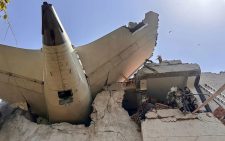Concern as rare World War I battlefield sites fall in pieces

Tucked in a quiet edge of Taveta town in Taita Taveta county near the well-tended Indian Memorial Commonwealth War Graves is a large sprawling brick building that is falling apart.
The brick walls, once imposing and beautiful, are ugly and tattered. The paint is shedding from decades of exposure to the elements.
The roof is brown with a thick coat of rust. Some parts have caved while others have developed holes. The building’s thick foundation is decaying.
Underneath, layers of huge stone boulders that an unknown architect from over a century ago had expertly fixed to support the entire structure jut out. The wooden doors are rotten while the windows are merely skeletal bars.
Inside, it is cold. The heavy air has gone rancid from the unmistakable alkaline smell of bats’ excrement.
The walls are damp and moldy from years of soaking in moisture. The gloomy interior has a dejected quality that characterises abandoned homes.
Clinging to it all is a sobering sense of a vast age and creeping dilapidation over a monument with great historical significance that now teeters on verge of total decay.
This wasted appearance aside, this ancient building fascinates local and foreign history buffs whose stock-in-trade is the genesis and exploits of the First World War.
“This is the old District Commissioner’s House where the first shot that triggered World War One (WW1) in East Africa was fired from,” explains Willy Mwadilo, manager of Taita Hills Safari Resort and a WW1 historian.
Destructive activities
The old DC’s House is one of the several historical WW1 sites in Taita Taveta that have recently come under threat from vandals and other destructive human activities.
Precarious situation is blamed on the absence of any official intervention to actively preserve items and scenes considered to possess profound historical value.
Mwadilo, who oversees a mini-WW1 museum packed with artefacts of war at Taita Hills Safari Resort, says there is an urgent need to protect the sites and save a part of Kenya’s history that remains unknown to many.
He notes that many people are unaware that an important part of the WW1 global campaign occurred in Kenya with thousands of residents being conscripted as soldiers or porters for carrying supplies.
“Kenya, and Taita Taveta in particular, was a key actor in the East Africa Campaign of the First World War. This is a historical legacy that should be secured for future generations,” he said.
Historically, World War 1 started on July 28, 1914. By the time the pogron ended on November 11, 1918, an estimated two million people were dead.
Chroniclers of this war argue that half of the dead were casualties of Africans descent. Majority were porters who carried supplies, weapons and food for the British soldiers.
More tragically, poor communication between Africa and Europe would see the fierce fighting in Africa continue for two more weeks after the war in Europe had already ended.
Taita Taveta holds a special place in the history of the First World War. It was an active battleground between British and German forces. As a result, the region is home to several unique sites that have historical significance related to this great battle.
Some sites are secure because they fall under protected areas. However, it is the others where the members of public have unfettered access that is giving historians sleepless nights.
“The battle sites inside Taita Hills Sanctuary and Tsavo National Park are relatively safe because there is no unauthorised access. Our greatest concerns are for other sites that are getting rapidly degraded,” said Mwadilo.
His fears are justified. Already, a British machinegun encampment near the Picket Hill in Maktau area is no more.
The embankment, made from rock boulders, was destroyed after an unscrupulous resident carted away rocks for construction. Such is the danger facing unsecured battlefield sites.
However, Mashoti Fort and Bridge 27 located inside Taita Hills Sanctuary are intact. Mashoti Fort was a British fort where soldiers received supplies before being deployed to the battlefront.
Uncelebrated soldiers
A century later, the battle trenches are still visible though overgrown with grass. In 2018, a plaque was erected at the top of the hill to commemorate thousands of uncelebrated African soldiers who died in battle.
Slightly over a kilometer away is Bridge 27. This railway bridge was a target for Germans, who had repeatedly tried to blow it up to disrupt the flow of supplies that came by train.
Other historical sites include the Picket Hill in Tsavo West National Park and Sniper’s Baobab where a legendary German female sniper mowed down dozens of British troops before she was neutralised.
Livingstone Mghenyi, a domestic tourism champion and the Manager of Mlilo Tours and Safaris, said unless the government intervened, there would be little left from the WW1 era for future generations to learn from. Loss of such history at a time tour stakeholders are promoting battlefield tourism is unimaginable.
Mghenyi cited the case of a machine gun embankment that has been vandalised. “This is the extinction of history.
The rocks are gone,” says the tour operator. He warned that other sites are becoming decrepit and falling into ruin.
Famous Salaita Hill in Taveta was the last stand in a bloody battle between Germans and British troops.
Former Taveta MP Basil Criticos has fenced it off. Though locals say Salaita Hill is too important and should be converted into public land, officials say the hill is part of Criticos’ land. The fencing has also kept vandals away. – KNA













